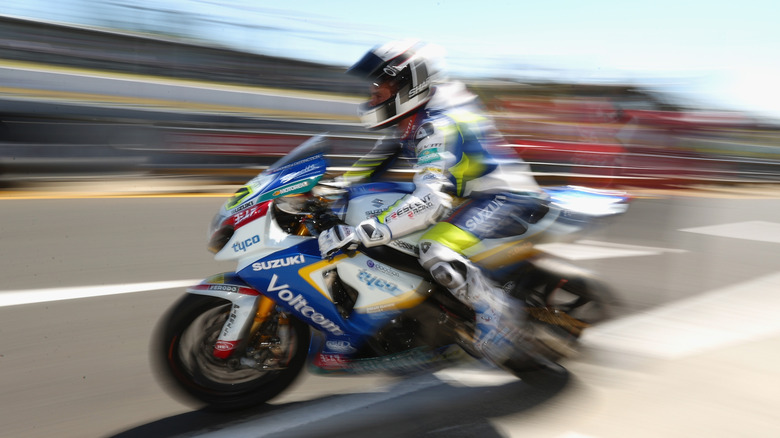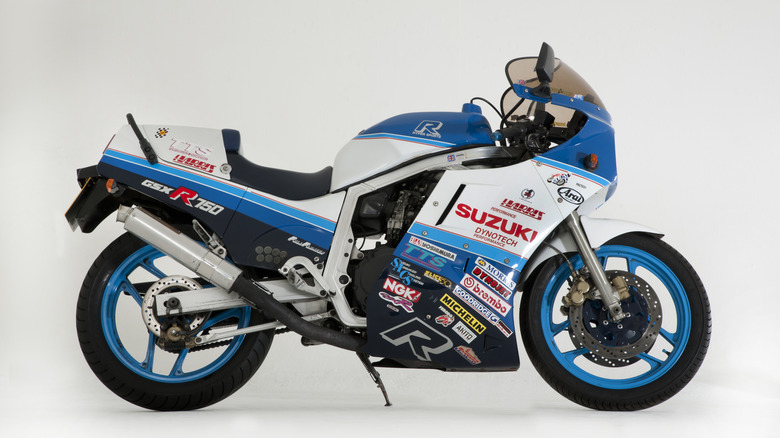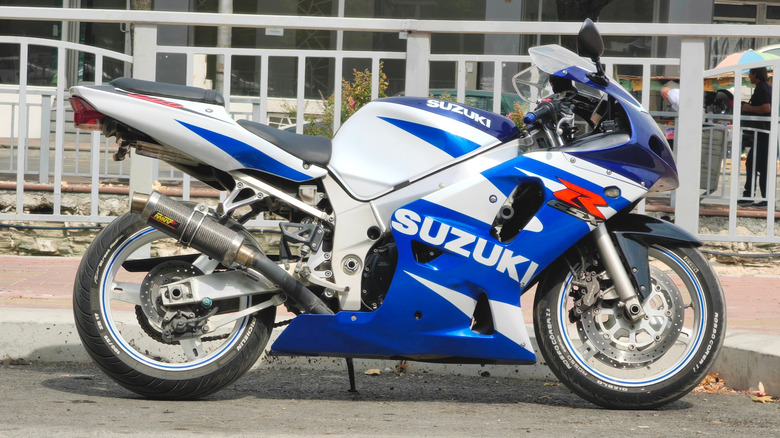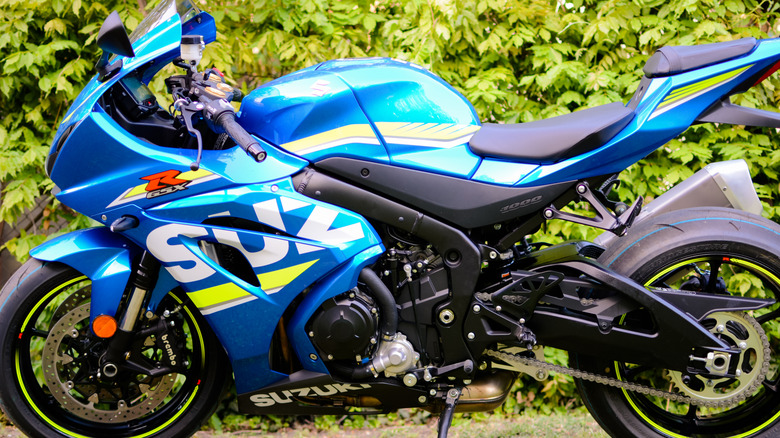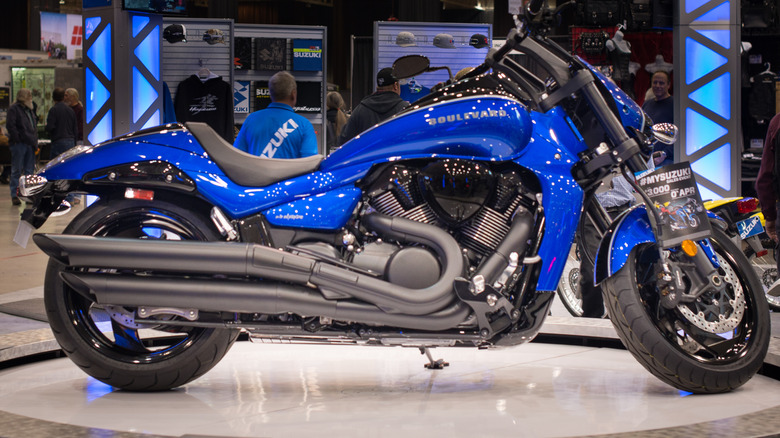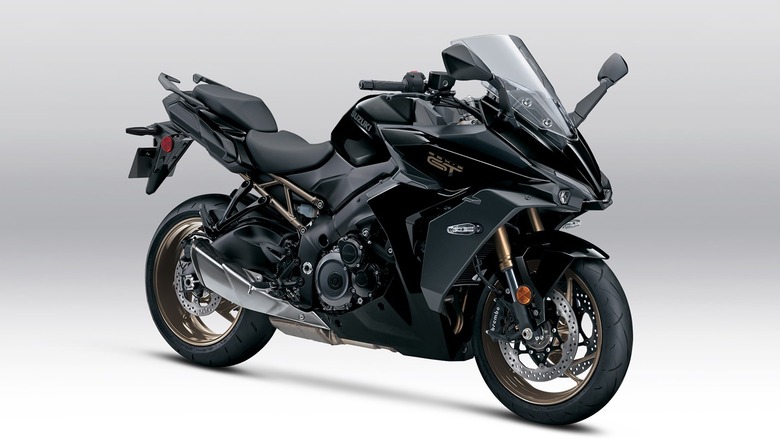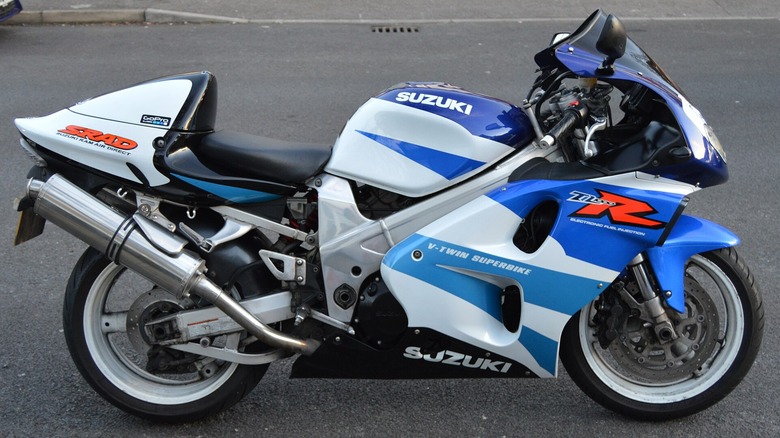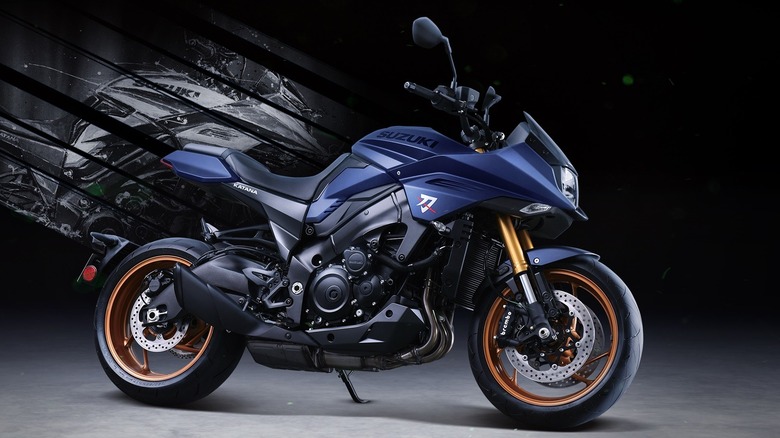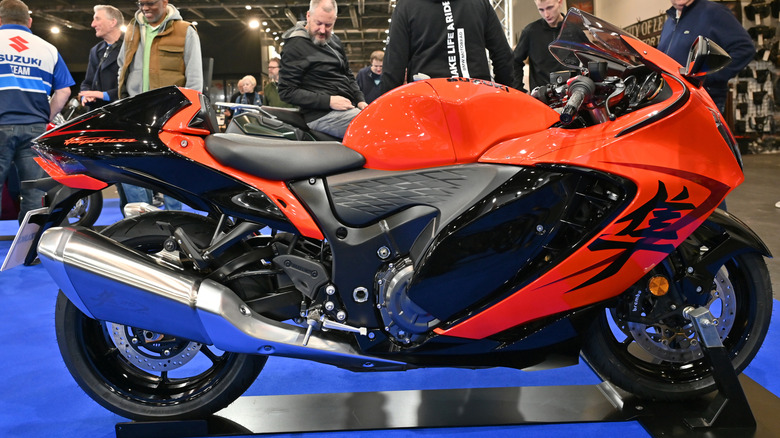8 Of The Most Powerful Suzuki Motorcycles Ever Made
In 1952, Suzuki introduced its humble entry into the automotive field with the Power Free, a 36cc two-stroke auxiliary engine attached to a bicycle. The company had been operating since 1909 but clearly felt it was on to something; by 1954, it had changed its name from Suzuki Loom Manufacturing to Suzuki Motor Co.
Since then, Suzuki has competed fiercely with Kawasaki, Honda, and Yamaha for motorcycle supremacy. These battles have taken place on the streets, racetracks, and markets of Japan and the wider world. The company scored a TT championship in 1962, just in time for the power race amongst manufacturers to begin heating up.
After more than half a century, Suzuki is still among the top performance motorcycle producers. The former (and future?) champion of the fastest production motorcycle title Suzuki Hayabusa is nothing short of a legend, and that's to say nothing of the brand's vaunted GSX and GSX-R lines.
Join us as we explore Suzuki's history of power and performance in our list of eight of the most powerful Suzuki motorcycles ever made.
GSX-R750
In 1985, Suzuki set out to reinvent street bikes. Racing bikes if the mid-'80s mainly consisted of 500cc and 750cc two-stroke track machines. Suzuki wanted to discover what would happen if it built a street-legal bike equipped for the racetrack from the ground up.
Etsuo Yokouchi of Suzuki's engine design department was tasked with developing the new GSX-R. It had to be lightweight, advanced, and 750cc — the sector of the market Suzuki deemed receptive to disruption. After years of testing and design, Yokouchi delivered an air-cooled, 100 bhp four-cylinder nestled into an all-new, 17-pound aluminum frame (the previous frame weighed 40 pounds.
The Gixxer splashed. The market became filled with candy-colored sports bikes that delivered incredible power in a new way. Riders who wanted to enjoy the nimble flick of the new superbike flocked to streets and tracks astride their GSX-R750s.
The Gixxer 750 had a long and illustrious career before ending sales internationally in 2018, with one last edition for the United States in 2019. By then, it was a 150 hp sportbike with nowhere to go. Market dictations and racing rules changed the market, sadly eliminating a machine that marks a significant milestone in performance motorcycling.
Though the GSX-R750 died an early and undeserved death, its place in motorcycle development continues to live in the GSX/R line of Suzuki performance.
GSXR-600
Taking what it learned from developing the GSX-R750, Suzuki introduced the GSX-R600 in 1992 as a race bike. From 1992 to 1996, the OG GSX-R600 was unavailable outside North America and is relatively rare today. It wasn't until 1997 that the street-going middleweight racer was officially introduced for Supersport racing with its second generation.
The second-gen Gixxer 600 had a 599cc in-line four-cylinder in what was otherwise a GSXR-750 package. It made between 91 and 100 hp in a package 11 pounds lighter than the 750. At its debut, it was a handling machine that could accelerate faster than any of the bikes in its class. Suzuki racked up back-to-back World Supersport titles in 1998 and 1999, and a legend was born.
Suzuki gave the 600 a complete update in 2001, just in time for the early-aughts superbike bloom. As a middleweight, it was approachable (if still a tad risky) for inexperienced riders to sling a leg over. Suzuki continued to develop it through the new millennium, but chaos in the 600cc segment has seen it survive the death of its rival YZF-R6 and the rise of Suzuki's GSX-8R.
With Suzuki's Drive Mode Selector system managing around 100 hp, Brembo brakes, a Showa shock system, and a pedigree of racing success behind it, the $11,999 2025 Gixxer 600 is significantly more advanced than the original. The future may be uncertain for the 600 class. But it seems alive and well at Suzuki.
GSX-R1000
Just a year after the 1985 introduction of the GSXR-750, Suzuki introduced a 1,100cc model that lived on until 1992. A smattering of Gixxers hit the market in various displacements, but after the introduction of the game-changing Yamaha R1 in 1998, Suzuki got into the literbike game.
The GSX-R1000 debuted in 2001. Essentially identical to the thriving 750 in the frame and chassis departments, the new bike's headlines were about power and suspension. Its 998cc liquid-cooled in-line four-cylinder made 160 hp against a wet weight of 374 pounds. Suzuki used the same cylinder head and increased the bore by 1 millimeter and the stroke by 13 millimeter. Paired with dual-throttle electric fuel injection, it was a torquey (for a sport bike) meteor.
Unlike the 750, the liter superbike continues production today. The 2024 GSX-R1000R has an MSRP of $18,649, nearly 200 hp, and 81 lb-ft of torque. Its wet weight is 443 pounds, but much of that weight includes systems like ABS, traction control, and other amenities associated with modern motorcycling.
Each of the big four manufacturers has stuck with a 1,000cc configuration in a market that has seen many changes since the Gixxer's debut. The power wars have pushed the development of the Kawasaki H2R and Suzuki's own Hayabusa, but the GSX-R1000 remains one of the most potent jewels in Suzuki's crown.
Boulevard M109R B.O.S.S. Edition
Shifting gears, we step away from supersports for a moment to examine a different kind of power. Motorcycles are incredibly versatile. How they make and deliver power varies wildly between class and engine configuration. For those who are fans of cruiser-style bikes with V-twin performance, Suzuki has the Boulevard M109R B.O.S.S. Edition.
Suzuki's cruiser line includes four bikes, each a variation of the Boulevard, but the M109R is the king of its cruisers. With a base MSRP of $15,599, it's a sleek road machine aesthetically distinct from the Harley-Davidsons that often inspire the V-twin motorcycle design.
The 1,783cc 54-degree V-twin (109 cubic inches) is triple the size of the GSX-R600 but delivers its 128 hp and 118 lb-ft of torque very differently. The thumping twin uses some of the largest pistons in the industry, but is anything but crude. Suzuki coats the cylinders in Suzuki Composite Electrochemical Material, a race product that optimizes heat transfer and reduces weight. It also uses fuel injection and a dual throttle system that has been praised for smooth power delivery throughout the range.
The M109R has a different flavor from Suzuki's sportbikes. It lacks ABS or traction control. And given that it 764 pounds, trying to drag a knee on this thing would likely end in disaster. Yet, Suzuki builds all kinds of bikes, and with that big, honking V-twin, the M109R is one of the most powerful in its modern stable.
GSX-S1000GT
The GSX-R1000 lent a lot to Suzuki's new line of sport-touring motorcycles, and the cream of that crop is the GSX-S1000GT+. Supersports are great fun, but what happens when you want to enjoy that performance for longer than half an hour at a time? The GSX-S1000GT (and its competitors) mix the best of both worlds with near superbike performance in a more comfortable and sophisticated package.
Let's get to the numbers. In a test run by Cycle World, the S1000GT made 135 hp at the wheels at 10,360 rpm and 73 lb-ft of torque at 9,190 rpm. The engine was derived from the GSX-R1000, and while it might not be as eye-popping as the Hayabusa, its 498-pound curb weight gives it a power-to-weight ratio akin to that of a Mazda Miata with 600 hp. In other words, plenty.
To make all that power comfortable and manageable, Suzuki employs a suite of electronic rider aids, including a bidirectional quick shifter, ride-by-wire throttle bodies, and Brembo brakes. Perhaps the most critical is Suzuki's Intelligent Ride System, which includes a three-mode drive selector and a five-mode traction control system.
The GSX-S1000 series is still new, appearing for the first time in 2022, and only time will tell of its legacy. For now, it's the closest a sport-touring fan can get to a Gixxer 1000 that doesn't feel like a straight race bike.
TL1000R
Not so fondly remembered as the beloved GSX-R, the TL1000 was an ill-fated supersport built by Suzuki between 1997 and 2003. The TL looks just like the early Gixxer 1000, but beneath its flashy fairings lay a dark secret: it was Japan's first V-twin superbike. Suzuki envisioned the TL competing with Ducati for World Superbike bragging rights. With the same bore (98 millimeter), stroke (66 millimeter), and displacement (996cc) as the Ducati 996, surely Suzuki's experienced team could develop a real contender. Not so much.
Though it remains one of the most potent Suzuki bikes ever built with 136 bhp, this bike never saw a World Superbike contest. As the short production run hints, the proposed Ducati killer encountered some problems. Not the least of which was a flawed rear damper unit, poor handling, and ineffective brakes. The engine's difficulty to race tune contributed to its never appearing on the track.
Today, the TL1000R is remembered as a footnote in motorcycle racing history, but they're still around. According to J.D. Power, a 1998 model in excellent condition is worth around $6,000 — not bad for one of the earliest V-twin Japanese superbikes and one of the most powerful ever made by Suzuki.
[Featured image by RubSub via Wikimedia Commons | Cropped and scaled | CC BY-SA 4.0]
Katana
Lurking in the background of Suzuki's performance bikes, a not-often-spoken-of motorcycle has recently received a second life. Despite a muted reputation, the Suzuki Katana predates every motorcycle on this list. It appeared in 1979 as a stepping stone between the standard UJM and the fully-faired street racebikes right around the corner.
Suzuki unveiled the Katana at the 1979 Cologne show in Germany. It was a significant departure from UJM design and represented Japanese quality mixed with European flair. The GSX1100S launched officially in early 1980 and featured various displacements until its discontinuation in Japan in 2001. But that wasn't the end of the Katana.
Suzuki brought the Katana back in 2020. The new Katana employs a 999cc inline-four cylinder sourced from Suzuki's work on the GSX-S1000GT and GSX-R1000. It has a bona fide performance pedigree backing it up. The engine makes between 147 and 150 hp against a weight of 474 pounds.
The pugnacious Katana is a half-naked street fighter with an eclectic look. From a power perspective, it can certainly hang with the market's top dogs. With more of an upright position than the Gixxers, it is a powerful addition (or return) to Suzuki's lineup.
Hayabusa
For years, the Suzuki Hayabusa held the coveted title of the world's fastest production motorcycle. Suzuki designed it from the ground up to kill Honda's then-reigning speed champ, the Blackbird CBR1100X. It even named the upstart after the Japanese word for "falcon" — a bird of prey known to hunt blackbirds.
Subtlety was never the Hayabusa's strong point, and the proof is in its radical looks. Where many competition motorcycles are all angles and edges, the 'Busa is luscious and curvaceous. Buried in that polarizing design is a 1,340cc in-line four-cylinder making around 200 hp, depending on conditions and tuning.
The modern Hayabusa comes with Suzuki's rider aids and traction control, which helps mitigate some of the raw power, but it is strictly for experts only. 2024 marks the 25th anniversary of the nameplate's debut. Suzuki celebrated with a 25th-anniversary edition that costs $19,599, while the standard edition costs $19,099.
There are many ways to measure power, but pound for pound, the Suzuki Hayabusa is not just one of the most powerful motorcycles in the Suzuki collection, but of all time.
